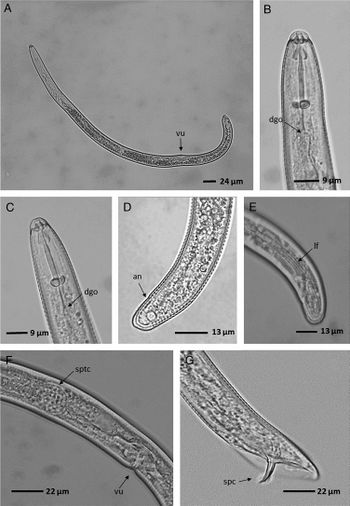Helicotylenchus multicinctus
From Pestinfo-Wiki
| Literature database |
|---|
| 68 articles sorted by: |
| • year (descending) |
| • research topics |
| • countries/regions |
| • host plants |
| • list of antagonists |

Light microscope images of Helicotylenchus multicinctus - A) whole female, B+C) anterior region, D+E) posterior region, F) middle region of female, G) posterior region of male - vu=vulva, dgo=dorsal esophageal gland orifice, an=anus, lf=lateral field, sptc=spermatheca, spc=spicule (click on image to enlarge it)
Author(s): Donald Riascos-Ortiz et al.
Source: Journal of Nematology (2020) 52, art. 54
Author(s): Donald Riascos-Ortiz et al.
Source: Journal of Nematology (2020) 52, art. 54
Helicotylenchus multicinctus (Cobb, 1893)
This nematode is a widely distributed in tropical and subtropical regions, but has been also found in greenhouses in temperate countries. It is a serious pest of banana, but infestations have been also reported from rice, pineapple, date palms and other crops. The outer layer of the roots is attacked, resulting in lesions and root deterioration. On banana, yield losses of 30% and more have been reported, e.g. see Roderick et al. (2012).
Fully grown nematodes are around ½ mm long and c-shaped when relaxed. The stylet is well developed, 20-25 µm long, with prominent basal knobs that are flattened anteriorly and rounded posteriorly.